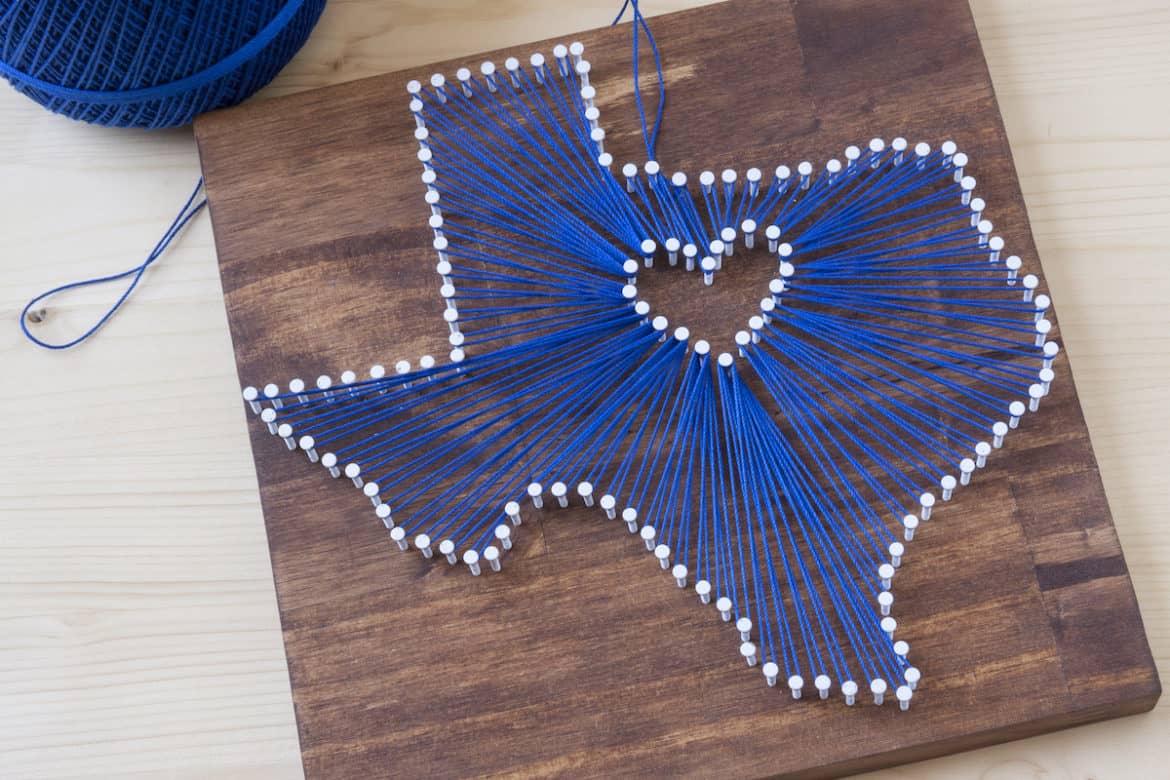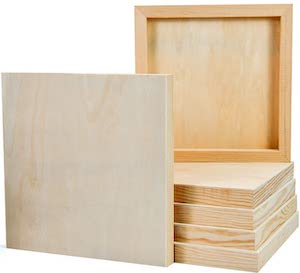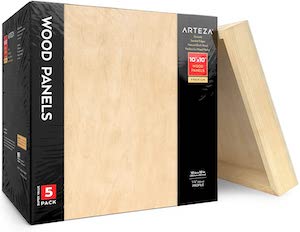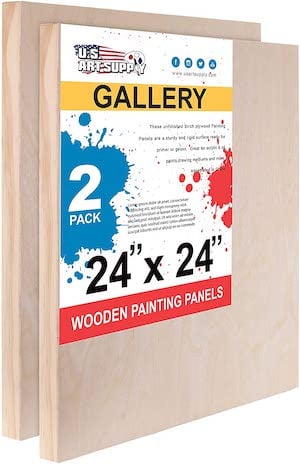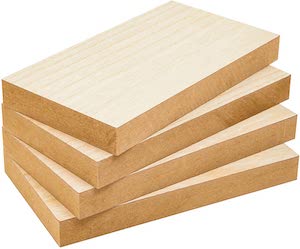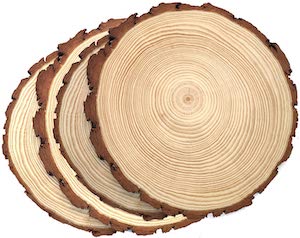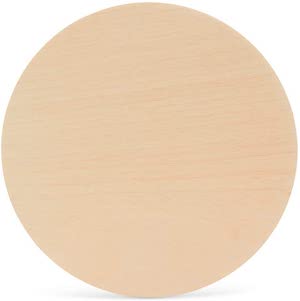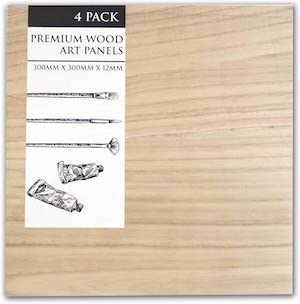So, you’ve decided to pick up the hobby of making string art. It is a fun, rewarding activity that can help you create beautiful artworks to decorate your home as well as give as presents to your loved ones.
As with any other hobby, you will need a dependable set of tools and materials to create beautiful and long-lasting pieces. Whether you are a complete novice or someone who has dabbled in making string art before, buying quality materials should be the first step when you want to start a project.
So what is the best wood to use for string art? The best wood for string art is an unfinished soft wood. This can be natural (such as cedar or pine) or processed, such as MDF, plywood, or particleboard. Your board should be at least 1/2 inch thick.
When it comes to wooden boards, there are so many types of wood that would work with string art. If you need help selecting a perfect wooden board for your new string art piece, here’s a complete guide to help you get started.
What is String Art?
String art is a simple, versatile hobby that requires very few tools and materials when you get started. You’ll need a wooden board to act as your “canvas,” a set of nails to outline your shape and act as anchors for the string, and a lot of patience.
The process sounds simple enough, and there are beginner patterns that take very little skill and time to make. If you are a beginner at string art, you can start with simple shapes like the outline of your initial, the shape of your hometown, or even a small heart.
Once you’ve decided on a shape, you can print out the shape and trace it on a piece of wooden board. If you want, you can score the board to do this. Take a thumbtack and perforate the shape through the paper and onto the wood. You can space these perforations out to line your nail placements at the same time.
After you’ve traced your shape, small nails are secured around this outlined shape, spacing about ¼” to ½” apart. These nails will act as guides to anchor the string, which then will be wrapped around the nails to “fill up” your shape with colors and gradients.
Depending on the design, string art varies in difficulty, with simple pieces using only one color and one simple shape, and more advanced pieces using multiple colored threads to create depth and details.
Even if you’re a complete beginner, the steps are quite straightforward, so it only takes some patience and sturdy hands to get started.
How to Select the Best Wood For String Art
If you want your string art piece to last in your home for a long time, make sure to invest in quality materials that can withstand the test of time.
Wooden boards and canvases are most commonly used for string art.
We recommend using softwoods like cedar or pine, or even processed woods like particleboard or plywood. These types of wood are softer, which means that nails can sink easily into the material. Once the nails are hammered in place, they should be secured and ready to form your piece.
Hardwoods are more commonly used in construction because they are quite strong and difficult to work with. Although you often see hardwoods like walnuts in a lot of craft stores, they are not great for string art because you would find it difficult to hammer nails into the hardwood.
Natural softwoods are usually used in construction because they are designed to withstand the elements, especially humidity. Natural softwoods usually appear more rugged and less polished, so they are great if you’re opting for a vintage look.
However, since your art piece will be displayed inside, there’s no reason besides aesthetic to invest too much in a piece of pine or cedarwood.
A great alternative is using processed wood like MDF, plywood, or particleboard. These options are more commonly found in craft stores, and the quality is still excellent to create a beautiful piece of string art.
Pay attention to the size and thickness of the board you are using. Before you start, you should estimate how big your piece would be, and buy a wooden board to match the size.
You should also make sure that the board is at least 1/2 inch thick (but closer to 1″ would be much better) so that the nails can be hammered in place without poking through the other side.
If you are using smaller or larger nails, match the thickness with the size of your nails to make sure that the nails can be secured in place without damaging the board permanently.
When you buy wooden boards for string art, it’s best to buy unfinished wood.
Make sure to avoid melamine-coated woods, since this type of finish will not work for nails. It will leave cracks and uneven edges when you insert the nails, so the finished results will not look neat and polished.
You can opt for wooden canvases or unfinished boards. If you’d like the wood to be a different color, you can stain or paint the canvas before starting your piece. This step will allow you to choose the quality of wood that you’d like while still achieving the best aesthetic for your artwork.
If you decide to stain or paint the wood, make sure that the paint is completely dry – which takes up to 24 hours – before adding nails to the board.
Best Wood For String Art
Now that you know what to look for, below are our top picks for the best wood for your string art:
| Rank | Products | Description |
|---|---|---|
| 1. | YoleShy Unfinished Wood Panel Boards | 8x8" unfinished light wood canvas panels |
| 2. | Arteza Wooden Canvas Board | 10x10" unfinished birch canvas panels |
| 3. | U.S. Art Supply Birch Wood Panel Boards | 24x24" unprimed birch canvas panels |
| 4. | Bright Creations Unfinished Wood Block | 5x9" 1-inch thick light wood blocks |
| 5. | MUPIANLX Pine Wood Slabs | 9 to 11" pine tree rings |
| 6. | Woodpeckers Wooden Circle Plaques | 24" round unfinished birchwood, 1/2" thick |
| 7. | OldBleu Wood Art Panels | 12x12" light wood panels, 1/2" thick |
We have a full review of each below, so keep reading to pick out the best wood for your string art project. Happy crafting!
1. YoleShy Unfinished Wood Panel Boards
This canvas board is often used for painting, but it’s also a perfect size for a smaller piece of string art.
Since this canvas board was created for painting, it is a bit thinner than other types of wooden boards, at 0.67” thick. However, it should still hold small nails really well, and perfect for minimalistic pieces that don’t require a lot of nails and string.
When you use a thinner board, make sure that you budget enough space between the nails to make sure that the board doesn’t crack and the finished product won’t look too crowded.
Depending on the nail size, the amount of space between two nails should be at least half the length of your nails. For example, if you’re using 1” nails, the space between two nails should be at least 0.5”.
The natural wood grain of this board adds a nice detail to your piece, but if you don’t like the unfinished texture, you can paint over the board with the color of your choice, and wait for the paint to dry before you start your piece.
This type of board will not work with wood stain, but you can opt for acrylic or oil paint instead for a more artistic look.
2. Arteza Wooden Canvas Board
This wooden canvas board is perfect for string art. The wooden board is made of softwoods, specifically natural birchwood and pine, so the nails will be allowed to sink easily into the board and held in place while you work.
This canvas board has a side profile of 1.5”, but the canvas thickness is only 5mm, which is very thin, so it would work best with smaller nails to create more minimalistic pieces. The 10” by 10” size would accommodate a smaller string art piece.
Despite its natural wood composition, the board is very lightweight and easy to maneuver. The surface is perfectly smooth, with sanded edges, so the finished result will look polished and put-together.
The natural wood material will hold up really well over time, so you don’t have to worry about maintenance after finishing your piece. This type of canvas board would hold wood stains and different types of paint really well, so you can consider treating the wood before starting your piece to give it a unique look.
3. U.S. Art Supply Birch Wood Panel Boards
If you are looking for a bigger canvas board that is a bit sturdier, this is a great option for you. This canvas board from U.S. Art Supply comes in various sizes and thickness, with the biggest size being 24” by 24” and 1.5” thick.
This canvas board is great if you are looking for some versatility in application, or hoping to incorporate painting in your string art design. These wood panels work well with every type of paint, so it’s ideal if you’d like to paint your board before starting your string art project.
Keep in mind that since this is a canvas design, the working surface is a little thinner than the size profile indicates, so it would only work with smaller nails and simple designs. While you work, you should space out the nails appropriately to make sure the panel won’t be damaged.
Compared to the other panel boards on this list, this option is a bit studier because it has extra support from two crisscrossing wooden bars in the back. This reinforcement means that the canvas will be firmer and more supportive as you hammer the nails in place.
4. Bright Creations Unfinished Wood Block
If you are looking for a sturdier option that can hold larger nails, opt for this unfinished wood block. Unlike the canvases, this woodblock is solid all around, so it will hold the nails firm in place and allow your finished project to have a structured look.
These wood blocks come in various sizes, with the biggest being 7” by 7”. If you’d like to make a larger piece of string art, you can use wood glue to combine several pieces together to create a larger surface. The blocks are 1” thick, so it can work with larger and thicker nails, allowing you to create a more sophisticated piece of string art.
The wooden blocks are made of high-quality MDF, so the wood is on the softer side to help the nails sink in more easily. This type of wood doesn’t crack when working with nails, and better yet, it will hold the nails in place really well, so it’s perfect for string art.
Although this product is made of processed wood, the surface is still smooth with some natural wood grain that provides a nice accent for your artwork. If you’d like, you can stain the wood to create an earthy look for your piece.
5. MUPIANLX Pine Wood Slabs
For skillful crafters, using natural wood is a great option to help them create sophisticated artworks. These round pine wood slabs will give your string art piece a unique vintage appearance and elevate the overall result.
Being made of pinewood, these slabs are really sturdy. Pine is a softwood, so nails can easily sink in the material and allow the nails to hold firmly in place while you work. The finished artwork will also be able to withstand the test of time because pine is known for being resilient and mold-resistant.
When working with a natural material, some wood bark may separate from the slices of wood, but overall, it will not affect the look of the finished product. The surfaces are sanded and polished, so you will still have a nice, even surface to work with.
Since this is natural wood, the surface will have flaws and natural markings. Some people like this imperfection, since it shows the quality of the wood, but you should keep this in mind when you select this type of natural wood for your project.
Overall, these rustic wooden slabs will give your artwork a vintage feel that’s really unique yet effortless, which will make a nice accent in a vintage home.
6. Woodpeckers Wooden Circle Plaques
If you’re planning on creating a circular design, these wooden circular plaques are perfect to accommodate. These wooden circles come in various sizes, up to 24” in diameter and 0.5” in thickness, perfect to accommodate a variety of styles and designs.
These circle plaques are made of plywood, which is a type of soft processed wood that would hold nails really well. Thanks to its sturdy structure and composition, the 0.5” thickness is enough to work with nails ranging from 0.5” to 1” in size. You shouldn’t have to worry about the nails poking through to the other side.
These plaques are beautifully designed with natural wood grain, but the surfaces are still smooth and easy to work with. This wood has a light color, but you can stain it to whatever color that you’d like. The colors will show up beautifully, creating a luxurious and sophisticated look.
We love that these wooden plaques are sustainably sourced, so they are perfect if you’re an eco-conscious shopper. Overall, this is a highly recommended choice thanks to its perfect size, thickness, and quality.
7. OldBleu Wood Art Panels
These art boards from OldBleu are excellent for string art, especially compared to other types of wooden panel boards that are thicker at the rim but very thin at the working areas. The wooden boards have a 0.5” thickness throughout. They are very sturdy and provide ample support for smaller nails when you create string art.
These boards are on the smaller side, so they would be perfect for small accent pieces of string art. We love that it is made of high-quality softwood that’s easy to work with, especially for beginners, while still being sturdy enough to hold the nails in place.
Being designed for art, this type of wood also holds paint and stain really well, should you choose a different background color for your piece. The surfaces are lightly sanded, but you can still see some natural wood grain that can complement your designs well.
Overall, this is a highly recommended option if you are new to string art, because it takes little effort to secure the nails in place while still achieving the same result. The boards are really lightweight, so it would be perfect for hanging if you want to proudly display your artwork once it’s finished.
Up Next: The Best String For String Art
